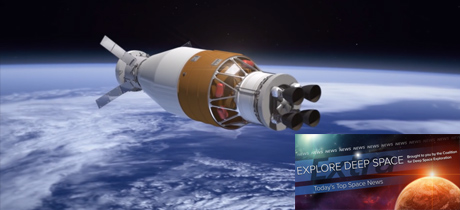In Today’s Deep Space Extra… Efforts by NASA to accelerate a human return to the surface of the Moon from 2028 to 2024 continue to spark debate. Scientists spot a record setting blast in space far from Earth. The Earth appears to have a temporary mini Moon.
Human Space Exploration
Cruz skeptical about prospects for NASA appropriations or other legislation
SpaceNews.com (2/27): Earlier this week, U.S. Sen. Ted Cruz, chair of the Senate’s space committee, joined a Space Transportation Association event in Washington to which he expressed doubts that any space related legislation, including spending bills, will make it through Congress this year. A Senate version of a new authorization measure, for instance, largely backs the administration’s exploration initiatives. A House version introduced in January, however, would slow the requirement for NASA’s return to the surface of the Moon with human explorers from 2024 to 2028 and direct the agency to focus on an orbital mission to Mars by 2033.
NASA planning document may offer clues to changes in Artemis program
Coalition Member in the news – Boeing
Ars Technica (2/28): The report discloses a document “Moon 2024 Mission Manifest,” reportedly circulated at the Marshall Space Flight Center that outlines the launch manifest for the first 10 Artemis Moon missions, ranging from April 2021 through August 2030 and using the Space Launch System (SLS) in Block 1, 1B and 2 upper stage configurations. The goal of returning human explorers to the surface of the Moon is reflected in the October 2024 fourth mission. NASA characterized the manifest document, which appears to diminish the role of a commercial Human Lander System, as having “many inaccuracies,” according to the Ars report. NASA is evaluating proposals for commercial lunar landers that would be integrated to a lunar orbiting, human tended Gateway and could award contracts in March. [Editors’ note/update: Within 30 minutes of publication of this report, NASA Administrator Bridenstine tweeted “This is not the plan”.]
Space Science
The MarCO mission comes to an end
NASA (2/27): NASA declared its twin small satellite MarCO mission at an end a bit earlier this month. The two CubeSats flew past Mars as the agency’s Mars InSight lander touched down on the Red Planet in late November 2018, relaying data during the descent. Contact with the solar powered, distance record setting small satellites was lost in January 2019. Another attempt at re-contact in September was unsuccessful. The technologies demonstrated by MarCO will be used by NASA as part of the Artemis human return to the lunar surface strategy.
Boom! Scientists spot the biggest known explosion in the universe
Space.com (2/27): Scientists believe biggest explosion in the universe may have originated with a black hole in the Ophiuchus star cluster, which lies about 390 million light-years from Earth, that is behind the most powerful space explosion yet observed. The Naval Research Laboratory led the study, published in the Astrophysical Journal, using NASA’s Chandra X-ray Observatory, which first noted possible evidence of the blast four years ago.
Astronomers discover a tiny new temporary Moon for the Earth. Welcome to the family 2020 CD3
Universe Today (2/27): Earlier this week, scientists affiliated with the Catalina Sky Survey noted what may be a temporary “mini Moon” circling the Earth. Less than 12 feet across, the space rock could have been captured by the Earth’s gravitational field about three years ago and now be in a position to exit in April. The incident is probably not all that unusual.
Other News
Northrop Grumman test fires new OmegA rocket second stage motor in Utah
Coalition Members in the News – Northrop Grumman, United Launch Alliance
Space.com (2/27): Northrop Grumman’s Castor 300, the 2nd stage for the company’s news OmegA rocket, underwent a test firing at company facilities in Promontory, Utah on Thursday. The 139 second ground test followed a similar test of the Castor 600 solid fuel upper stage in May 2019, a precursor. Northrop Grumman is developing the OmegA for the launch of future national security payloads under a$792 million, U.S. Air Force contract awarded in 2018. The initial launch of intermediate and heavy configurations of the OmegaA is anticipated in the spring of 2021. The USAF is expected to select among competitors Northrop Grumman, United Launch Alliance, Blue Origin and SpaceX for operational launches beginning in 2022.
SpaceX planning major increase in Florida launch activity
SpaceNews.com (2/27): SpaceX intends to step up its Florida Space Coast launch activity, according to a draft environmental statement filed with the FAA. The rise will come from the use of both NASA and U.S. Air Force launch pads for NASA, national security and commercial payloads. The company plans to add polar launches and a vertical payload integration tower to help streamline launch preparations.
Virgin Galactic sinks after top two analysts cut ratings
Bloomberg News (2/27): Shares of Virgin Galactic Holdings, Inc., slid Thursday after analysts from Morgan Stanley and Credit Suisse lowered their recommendations. Shares had risen earlier as the company works to establish a suborbital space passenger service. The start of launches from Spaceport America in New Mexico remains uncertain as test flight activities and others preparations continue. Earlier this week, the company disclosed a net loss of nearly $73 million during the fourth quarter of last year and a 59 percent drop in sales. A new initiative to market future passenger seats followed this week.

